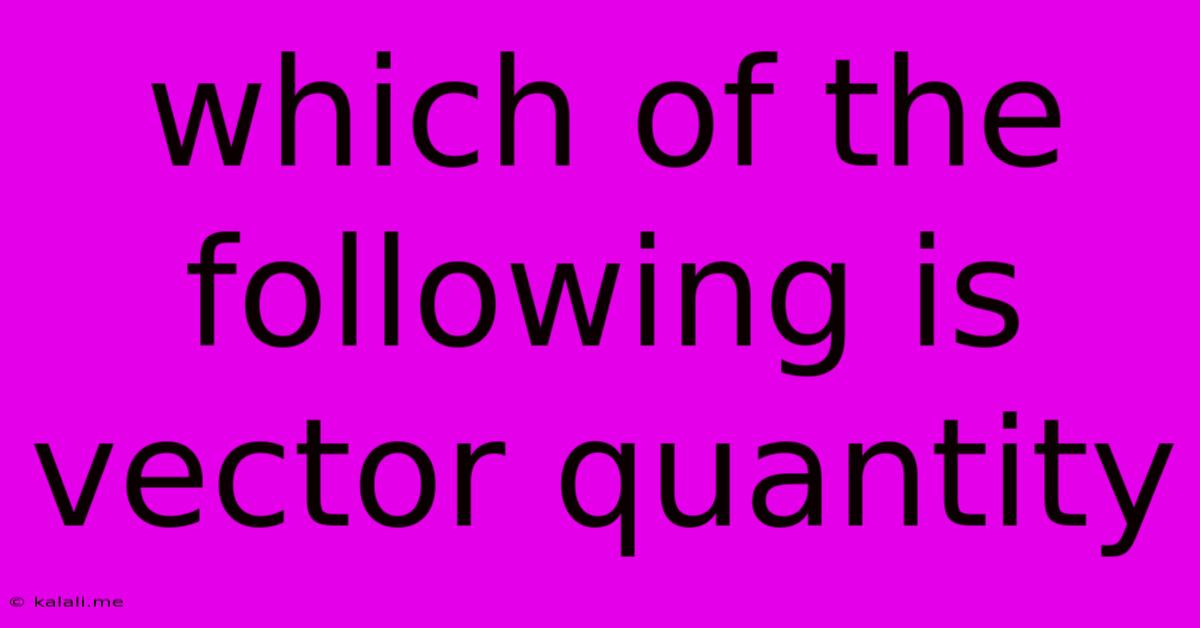Which Of The Following Is Vector Quantity
Kalali
Jun 11, 2025 · 2 min read

Table of Contents
Which of the Following is a Vector Quantity? Understanding Vectors and Scalars
This article will explore the concept of vector quantities, contrasting them with scalar quantities and providing clear examples to help you understand the difference. We'll delve into what makes a vector a vector, and equip you with the knowledge to identify vector quantities in various contexts. Understanding this distinction is crucial in fields like physics, engineering, and mathematics.
What is a Vector Quantity?
A vector quantity is a physical quantity that possesses both magnitude and direction. This means it's not just about how much (magnitude), but also where it's going (direction). Think of it like giving directions: saying "walk 100 meters" is incomplete; you also need to specify "walk 100 meters north." The 100 meters is the magnitude, and north is the direction. This complete description defines a vector.
Scalar Quantities: A Simple Comparison
In contrast, a scalar quantity only has magnitude. It doesn't have a direction associated with it. Examples include:
- Temperature: 25 degrees Celsius doesn't have a direction.
- Mass: A 5 kg object simply has a mass of 5 kg; no direction is implied.
- Speed: Driving at 60 km/h is a speed, but it doesn't specify a direction. (Velocity, on the other hand, is a vector.)
- Energy: The energy contained in a battery is a scalar.
- Time: The duration of an event is a scalar quantity.
Examples of Vector Quantities
Several physical quantities are inherently vector quantities. Here are some key examples:
- Displacement: This is the change in position of an object. It requires both a distance (magnitude) and a direction. Walking 100 meters north is a displacement vector.
- Velocity: This is the rate of change of displacement. It's speed with a direction. Driving at 60 km/h north is a velocity vector.
- Acceleration: This is the rate of change of velocity. It also has both magnitude and direction.
- Force: A push or pull on an object. A force of 10 Newtons pushing to the right is a force vector.
- Momentum: The product of mass and velocity, making it a vector quantity.
- Torque: A rotational force. It requires specification of direction (axis of rotation).
- Electric Field: Represents the force per unit charge at a given point.
- Magnetic Field: Describes the magnetic influence in a region of space.
Identifying Vector Quantities: A Key Consideration
When determining if a quantity is a vector, always consider if it needs both magnitude and direction for a complete description. If it only requires a numerical value (magnitude), then it's a scalar.
In Conclusion
Understanding the difference between vector and scalar quantities is fundamental to many scientific and engineering disciplines. By recognizing the defining characteristic of vectors – their possession of both magnitude and direction – you can correctly identify and work with these important physical quantities. This fundamental understanding lays the groundwork for more advanced concepts in physics and mathematics.
Latest Posts
Latest Posts
-
Is Keri Russell Related To Kurt Russell
Jul 02, 2025
-
What Is Half Of 1 4 Teaspoon
Jul 02, 2025
-
How Many Cups In A Pound Of Hamburger Meat
Jul 02, 2025
-
Imagery Or Figurative Language From Romeo And Juliet
Jul 02, 2025
-
What Is A Quarter Of A Million
Jul 02, 2025
Related Post
Thank you for visiting our website which covers about Which Of The Following Is Vector Quantity . We hope the information provided has been useful to you. Feel free to contact us if you have any questions or need further assistance. See you next time and don't miss to bookmark.